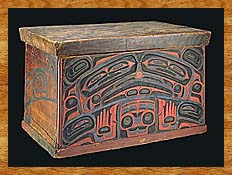
 North Coast North Coast
 Art Style Art Style
 Flat Design Flat Design
 Sculpture Sculpture |
The North Coast Art Style
Many features of what is recognized as the north coast art style are shared by the Haida and their mainland neighbours, the Tsimshian to the east and the Tlingit to the north. This is particularly true of flat designs, which use formlines and ovoids. Primary formlines, which are generally black, outline the parts of each figure. Secondary formlines occur within the primary spaces and are usually red. In rare instances, the two colours are reversed for dramatic effect. There is a formal grammar of formlines, in which rules control the thickness of the line and the changes of direction.
A rounded, bulging oval-to-rectangular shape called an ovoid is a feature unique to Northwest Coast art. Ovoids are used to portray a creature's eyes and joints, and sometimes teeth or orifices like nostrils and ears. Small faces are often placed within such ovoids; these refer to the loss of the soul as a prelude to death, for the Haida believe that the soul leaks out of the joints or orifices of the body.

 |
A red cedar bentwood Haida storage chest carved and painted with the protective image of Konankada, Chief of the Undersea World.
Collected at the Nass River in 1905 by W. A. Newcombe.
CMC VII-C-109 (S94-6802) |

The most common Haida artistic motif is the symmetrical flat design, made up of a complex pattern of components, that represents the Chief of the Undersea World. This supernatural being is prevalent throughout the Northwest Coast, from the prehistoric levels of the Ozette archaeological site in the State of Washington to the ancient burial chests found in caves in Alaska. One of the favourite designs of the Haida, it is a two-dimensional flat depiction of a being with a small body and an inordinately large, broad head that has a cleft in the forehead. The eyes often contain small creatures ranging from profile heads of salmon to double-profile heads similar in form to the larger head itself. The hands are also oversize, with emphasis on the palms, which in rare cases have separate faces portrayed within them. The arms, which are narrow and tightly folded, often have fins hanging from them. All the joints of the being's body are marked with eyes, heads of salmon or human faces. The overall impression is of undulating black bands that sketch out a broad face teeming with other life forms, which some interpret as souls of humans or other beings temporarily contained within this creature and awaiting rebirth into the world above the sea. George T. Emmons, who was the major recorder of Tlingit culture and a collector of Tlingit objects for a number of museums, made the following observation:
The belief in the mythical being Gonaqadet occurs along the whole coast. He lives in the sea, and brings power and fortune to all who see him. Sometimes he rises out of the water as a beautifully painted house-front inlaid with the much-prized blue and green haliotis-shell [abalone], again as the head of an immense fish or as an elaborately painted war-canoe. In decorative art he is generally represented as a large head with arms, paws, and fins.
Despite the great frequency with which the Haida depicted the Chief of the Undersea World on all types of containers such as food vessels, storage chests, chief's seats and even housefronts, they rarely identified it by name. We know, however, from Swanton's observations on Haida cosmology, that this ubiquitous being is called Konankada (or Gonankadet among the mainland tribes of the north coast). In the most general terms, it is the Master of Souls. Its nature is hinted at in the Haida myth of Master Gambler, whose house is mid-way on the journey to the land of souls, or the realm of Konankada. If those who pause to gamble lose to Master Gambler, more people will soon die in their village. If they win, however, the salmon runs in their village streams will increase. This alternation of souls between human and salmon forms one of the central equations of north coast art. The paradigm into which this and many other equations fit is the recycling of souls between human and animal (most frequently salmon) from one generation to another.
|